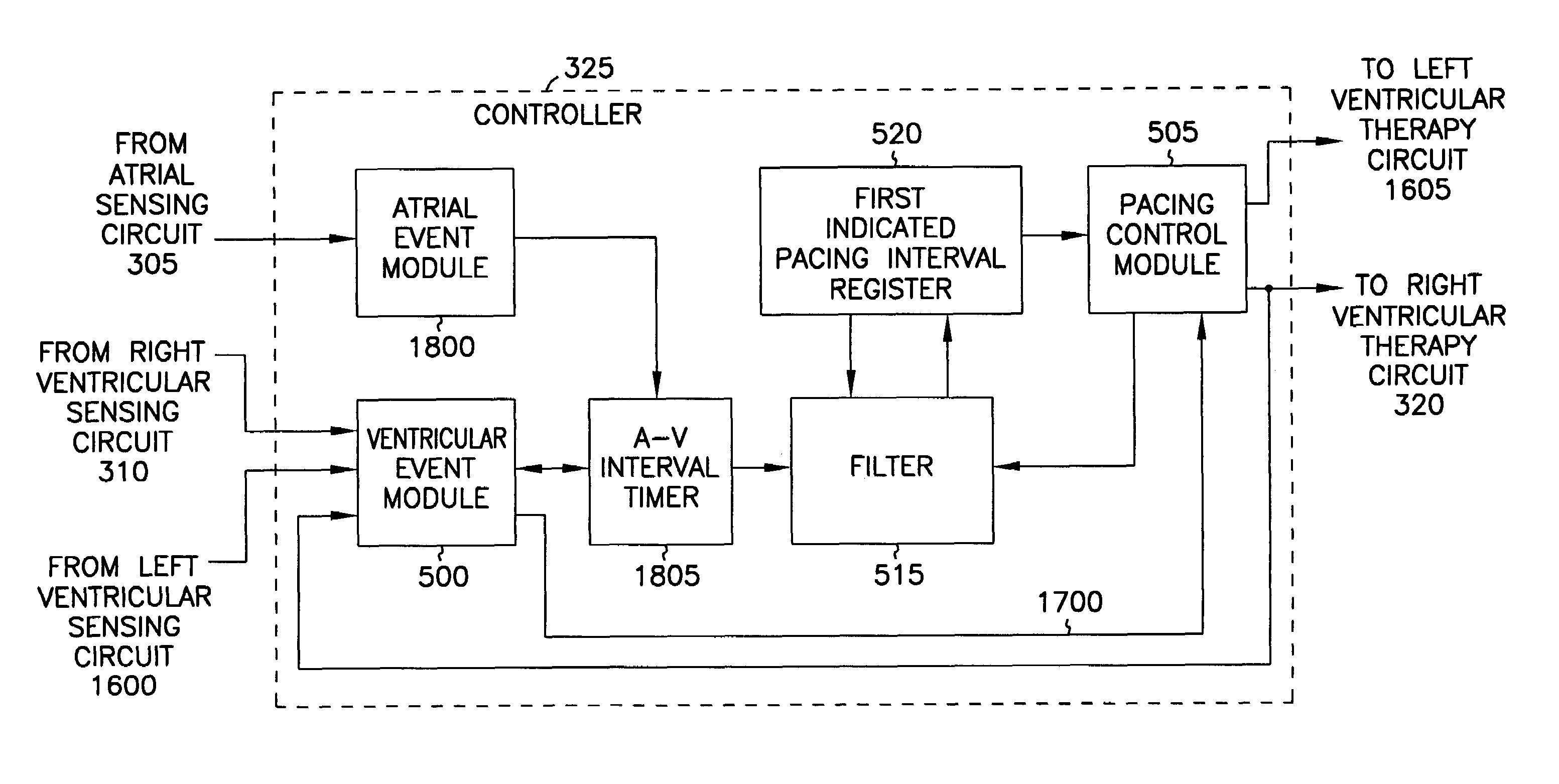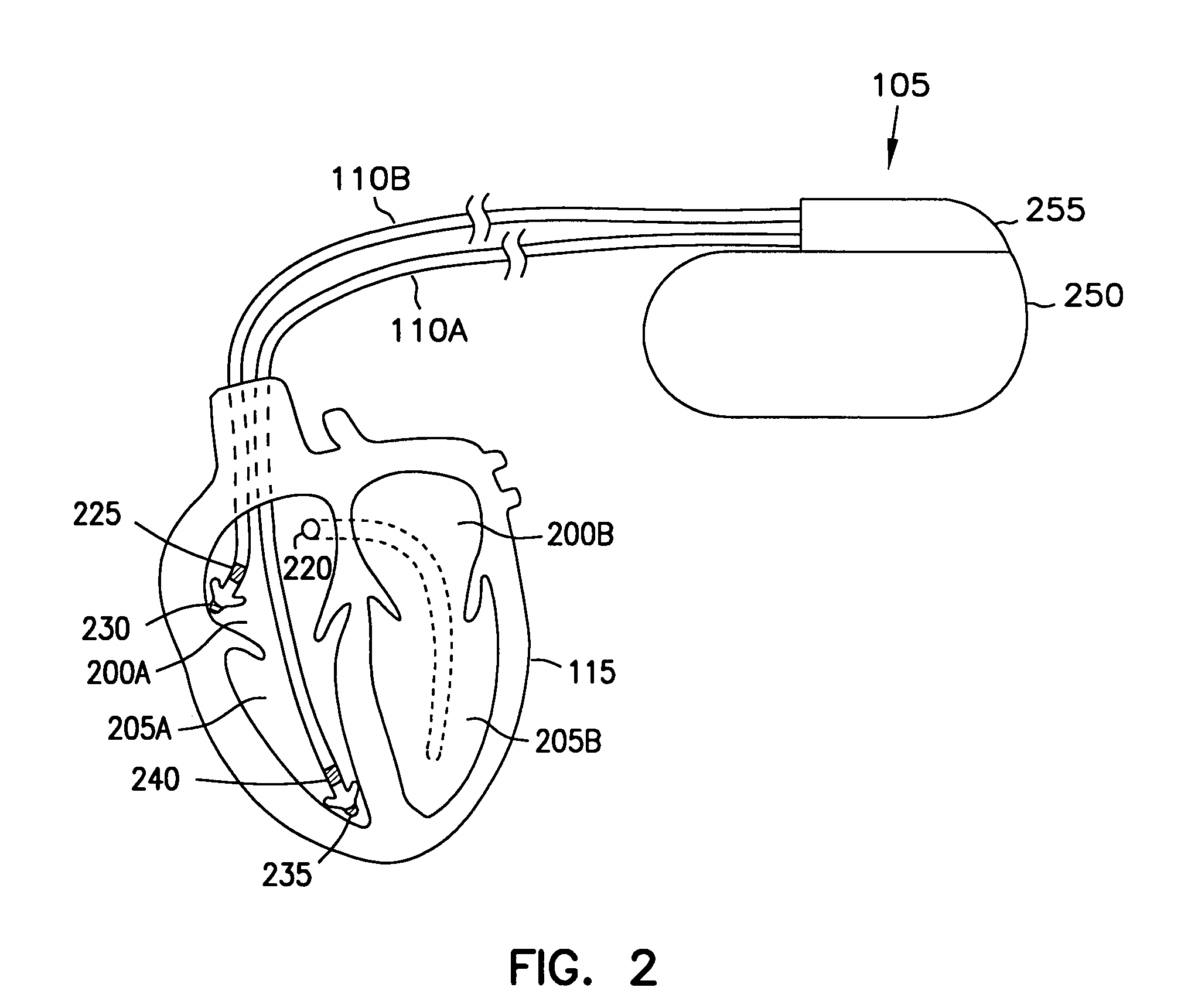System providing ventricular pacing and biventricular coordination
a biventricular coordination and ventricular pacing technology, applied in the field of cardiac rhythm management systems, can solve the problems of reducing blood circulation, drug therapy not always effective in treating certain patients' arrhythmias, and reducing blood circulation
- Summary
- Abstract
- Description
- Claims
- Application Information
AI Technical Summary
Benefits of technology
Problems solved by technology
Method used
Image
Examples
example 1
FILTER EXAMPLE 1
[0058]In general terms, for one embodiment, device 105 obtains V-V intervals between successive sensed or evoked ventricular beats. Device 105 computes a new first indicated pacing interval based at least in part on the duration of the most recent V-V interval and a previous value of the first indicated pacing interval. Device 105 provides pacing therapy delivered at a rate corresponding to the inverse of the duration of the first indicated pacing interval.
[0059]FIG. 6 is a signal flow diagram illustrating generally, by way of example, but not by way of limitation, one embodiment of operating filter 515. Upon the occurrence of a sensed or evoked ventricular beat, timer 510 provides filter 515 with the duration of the V-V interval concluded by that beat, which is referred to as the most recent V-V interval (VVn). Filter 515 also receives the previous value of the first indicated pacing interval (Tn-1) stored in register 520. The most recent V-V interval VVn and the pr...
example 3
FILTER EXAMPLE 3
[0067]In another embodiment, these coefficients can be more particularly described using an intrinsic coefficient (a), a paced coefficient (b), and a weighting coefficient (w). In one such embodiment, A=a·w, B=(1−w), C=b·w, and D=(1−w). In one example, operation of the filter 515 is described by Tn=a·w·VVn+(1−w)·Tn-1, if VVn is concluded by an intrinsic beat, otherwise is described by Tn=b·w·VVn+(1−w)·Tn-1, if VVn is concluded by a paced beat, as illustrated generally, by way of example, but not by way of limitation, in the signal flow graph of FIG. 8. If no ventricular beat is sensed during the new first indicated pacing interval Tn, which is measured as the time from the occurrence of the ventricular beat concluding the most recent V-V interval VVn, then pacing control module 505 instructs ventricular therapy circuit 320 to deliver a ventricular pacing pulse upon the expiration of the new first indicated pacing interval Tn. In one embodiment, the coefficients a and...
example 2
CONTROLLER EXAMPLE 2
[0077]FIG. 10 is a schematic diagram illustrating generally, by way of example, but not by way of limitation, another conceptualization of portions of controller 325, with certain differences from FIG. 9 more particularly described below. In FIG. 10, controller 325 includes an atrial tachyarrhythmia (AT) detection module 1000 that receives a signal from atrial sensing circuit 305. The received signal includes information about atrial events, from which AT detection module 1000 determines the presence or absence of one or more atrial tachyarrhythmias, such as atrial fibrillation.
[0078]In one embodiment, AT detection module 1000 provides a control signal, to pacing control module 505, that indicates the presence or absence of an atrial tachyarrhythmia, such as atrial fibrillation. In one embodiment, selection module 915 selects between the first and second indicated pacing intervals as illustrated, by way of example, but not by way of limitation, in Table 1.
[0079]
T...
PUM
 Login to View More
Login to View More Abstract
Description
Claims
Application Information
 Login to View More
Login to View More - R&D
- Intellectual Property
- Life Sciences
- Materials
- Tech Scout
- Unparalleled Data Quality
- Higher Quality Content
- 60% Fewer Hallucinations
Browse by: Latest US Patents, China's latest patents, Technical Efficacy Thesaurus, Application Domain, Technology Topic, Popular Technical Reports.
© 2025 PatSnap. All rights reserved.Legal|Privacy policy|Modern Slavery Act Transparency Statement|Sitemap|About US| Contact US: help@patsnap.com



